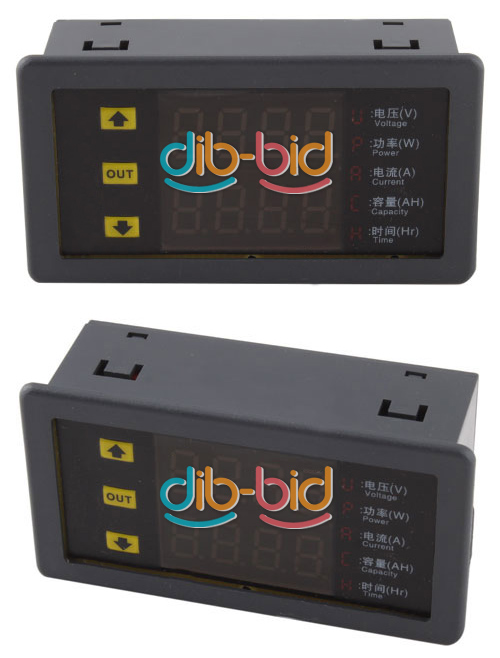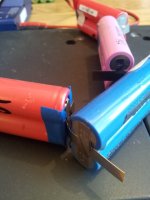Bulk Discharge - Capacity Test
Updated methodology ... for testing large quantities of cells - more precise.
Step 1
Charge all cells to identical voltage - 4.10V? - 4.20V? (Yes, 100th's is important)
Step 2
Allow all cell pairs to set for several days.
Remove any with a noticeable voltage loss - bleed down - self-discharge, more than ~2/100ths
Step 3
Test each cell pair with a trial discharge.
1 minute through any device with a substantial discharge amperage ~1000mA or higher. iMax B6 time discharge @ 1A, a 1000 lumen rated Cree XML flashlight, or ... .
Measure discharging cell voltage at 1 - 5 min. Mark cell as comparative IR rating, (4.20V-4.14V = .06V). Also note resultant voltage - 2 minutes(?) after discharge stopped
5 minute test could process a dozen pairs, 24cells, per hour and might indicate all cells liable to fail 2 hour discharge test!. (6 minute 1A discharge = 100mAh)
Important to measure voltages at cell with 100th V capable voltage meter, iMax voltage readings are skewed by multiple factors!
Remove any with excessive sag or lower resultant voltage.
This will confirm at least fair capacity and both cells functional.
Step 4
Prepare soldered 28s2p "strings" of cells. 28 x 4.2V = 117.6V DC
Begin the 1000mAh hour discharge using 2 x 60w light bulbs (120w).
Occasionally check voltage on each pair.
If any pairs getting low at 1 hour, (<3.8V? under discharge might not go 2 hours), remove and put in "1000mAh+" pile, save for continued testing with like cells.
Replace with spare pair, or pairs, make sure to tag them -1000mAh?
Step 5
Resume discharging.
Monitor each pair voltages and repeat replacements, (<3.7V under discharge), at 2nd hour put cells in "2000mAh+" pile, (40%+ capacity).
Monitor cells, you might want to schedule 1/2 hour, 500mAh replacements?
3 hours = 60% of original capacity for ~2500mAh cells.
I think, 60% + remaining voltage, to be a satisfactory capacity rating for recycled cells.
Mark pairs as 3000mAh + ( remaining static voltage eg 3.84v).
Pairs are effectively empty if they read 3.3V under a .2-.25C discharge, (= ~3.7V "static" - not discharging).
If unsure of cell rest voltage, disconnect 120w discharge temporarily.
Rebuild and continue testing strings of previously eliminated pairs, if any, test 2000mAh+ first.
Carefully monitor each pair, If they perform well for next 1/2 hour you can label all as 2500mAh+ their remaining static voltages. Every 6 minutes = 100mAh
Preliminary eliminations, 1st hour removals, if any, might not be worth the bother?
Even a 2 hour discharge, + the remaining voltage, is sufficient to build a nicely balanced pack.
Line up all cell pairs, best to worst.
Starting with best, lay them into banks ...
12s = ...
1 2 3 4 5 6 7 8 9 10 11 12 12 11 10 9 8 7 6 5 4 3 2 1 1 2 3 4 5 6 7 8 9 10 11 12 etc
9s = ...
1 2 3 4 5 6 7 8 9 9 8 7 6 5 4 3 2 1 1 2 3 4 5 6 7 8 9 9 8 7 6 5 4 3 2 1 etc
etc.
Unless you have a few exceptionally good or bad cells, this should build banks of nearly identical capacity.
Smaller than 28s will require a watt meter to maintain accuracy
Of course if you add a watt meter to your string you can pull cells at any time.
Make sure you use a 3-wire meter, = self battery powered, or you will lose discharged amount when disconnected to remove cells.
14s2p ~60v or fewer would work nicely, but 1000mAh discharge might require ~300w halogen floodlight.
If you want to maintain a .2-.25 discharge rate.
DC-DC 3.8V-60V (80V if 3wire) 20A Dual-display Digital LCD Power Current Voltage, AMP Meter, watt meter, Ah meter $13.69
I've been using one for several months ... love it!
Many more functions but sketchy instructions are in Chinglish
 Still believe this bulk method of capacity testing is not accurate enough?
Still believe this bulk method of capacity testing is not accurate enough?
Well ... then ...
Use bulk discharge method to discharge 28 paired cells for 3 hours (= 3000mAh ~60% of new capacity for pair of 2500-2600maAh cells).
Separate cells and use watt meter to discharge to desired "empty", possibly 1 hour more? (4000mAh = 80% of new rated capacity).
Bulk method would take 2-3 hours for 28 pairs but shows cell pairs of 2000-3000mAh (~40-60%) + resulting voltage, which is great for a comparative capacity between like tested cell pairs. (Discharging a typical sample further, in 100mAh steps and "mapping"resultant voltages, should effectively allow a reasonably accurate mAh rating for all cell pairs in the series!)
Bulk method + metered per each pair would take 3 hours + 28 hours =
31 hours for 28 pairs
Metered discharging each pair from full would take 4 hours x 28 =
112 hours for 28 pairs



